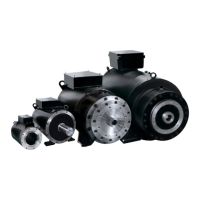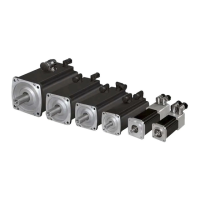TAM 00682 13
DSC 045-100 07 / 2012
Three-phase synchronous motor English
3 Mounting
3.1 Safety instructions
Before mounting:
Never mount or commission a damaged electric motor.
Never install the electric motor in a damaged machine.
Before mounting the electric motor, make sure it is suitable for your machine.
During mounting:
Only mount the motor using the fastening features provided.
The motor should not be exposed to knocks, e. g., with a hammer, or shocks when
mounting.
Make sure that all covers and safety devices are mounted. All safety devices must
comply with the latest regulations (e g. EN 60204).
Air cooling:
Protective guards have to be fitted to the air inlets and outlets, if there is a risk of foreign
bodies falling into the fan during operation.
3.2 Installation, fixing
Prior to and during mounting, check that
• The motor is not damaged (e. g., the shaft sealing ring must not have sustained any damage
at all from sharp or pointed objects).
• The motor is not mounted in the danger zone of other equipment.
• The motor is used for the designated purpose (see Sect. 1.2, Sect. 2.4).
(Observe nameplate details, warning labels, and signs.)
• Anti-corrosion agents have been fully removed from the shaft ends.
If a common solvent such as acetone or a cleaning solvent is used, it must not be allowed to
wet the shaft sealing ring.
• The motor is designed for the ambient conditions and environmental influences on site (see
Sect 2.4).
• The compartment in the machine is suitable for the cooling method employed for the electric
motor.
The motor is to be installed in such a way that heat can be adequately dissipated via the
housing surface and via the motor flange surface (refer to Sect. 2.6)
• The motor can be mounted and operated with the fastening features and connection data
provided.
The mounting dimensions of the motor and the tolerance details are provided in the technical
documentation that accompanies the product. When mounting the flanges on the motor, make
sure that the flange surface rests well and evenly. The supports and bearing surfaces must be
clean and undamaged. They must be precisely aligned with the connecting shafts to prevent
the bearings, shafts, and housing being exposed to damaging loads through misalignment
throughout the entire system. When tightening the flange fixing screws (min. property class
8.8), make sure that the flange connection is not distorted.
• No liquid can penetrate the upper bearing when installing vertically with the shaft end facing
upwards.
• The permitted radial forces according to the operating characteristics in the technical
documentation that accompanies the product are not exceeded (if necessary, contact
Baumüller for clarification).
The motor manufacturer must always be contacted if axial forces occur.
• The brake (optional) can be ventilated after the operational voltage has been applied (audible
operating noise).

